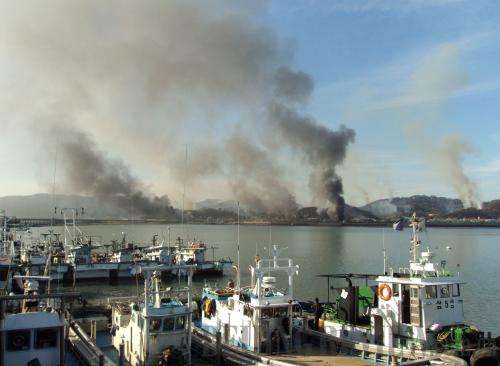|

In 2010, the situation on the Korean Peninsula was the most tense and complicated since the Korean War ended with an armistice in 1953. Conflicts between the Republic of Korea (ROK) and Democratic People's Republic of Korea (DPRK) intensified after the sinking of the ROK's Cheonan warship on March 26 and the exchange of fire near the Yeonpyeong Island on November 23. The peninsula and the region are now dealing with threats of war, and the choices made by the two nations and related parties will determine the chance of regional, and world, peace and stability.
Collateral damage
 |
|
FIGHT BETWEEN BROTHERS: Smoke billows from the Yeonpyeong Island on November 23, 2010, following an exchange of fire between North Korea and South Korea (XINHUA/AFP) |
Conflicts between the ROK and the DPRK are deeply rooted, both historically and geopolitically. Even though East Asia realized political reconciliation after the Cold War, neither shook hands on the matter. In the early 1990s, the United States threw out the nuclear issue with regard to the DPRK and aborted the reconciliation that had just started between the two sides. Since the DPRK nuclear issue was put on the table, Washington began to control the situation on the Korean Peninsula, leaving the peninsula in a semi-tense state.
From 1998 to 2008, two ROK presidents, Kim Dae Jung and Roh Moo Hyun, tried to abandon the U.S. track and achieve reconciliation with the DPRK. This was also intended to create the conditions needed for reconciliation between Washington and Pyongyang and a solution to the nuclear issue. It is undeniable that their policies, especially Roh's choice to act as a balancer in Northeast Asia, contributed greatly to the achievement of the six-party talks aimed at resolving the Korean Peninsula nuclear issue during that period.
But the ROK's internal political battle changed everything. Conservatives swept into power in the 2008 presidential election and returned to the U.S. track, casting aside Kim and Roh's policies. Instead, they hoped to solve all the problems on the peninsula at once, with a simple but tough stance. Unfortunately, the DPRK considered such a policy a total betrayal of past progress toward North-South reconciliation.
Shortly, the two sides entered full confrontation. On March 26, 2010, the ROK's Cheonan warship exploded and sank, killing 46. The ROK believed the DPRK had attacked the warship and responded by launching an economic blockage against the DPRK and staging large-scale military exercises. In the meantime, Seoul proposed two important policies: one was aimed at realizing South-North reunification as soon as possible and the other marked a shift in its military policy on the DPRK from defense mode to counterattacks or pre-emption, if necessary. The changing policy made it clear that future military conflicts could turn to war, as the ROK attempted to unite the whole peninsula.
Continuous military drills staged by the ROK and the United States didn't help ease tensions. On November 23, 2010, ROK troops performed artillery drills near the Northern Limit Line, a disputed maritime border between the ROK and the DPRK. After its protests fell on deaf ears, the DPRK overreacted and opened fire at the nearby Yeonpyeong Island, killing two ROK civilians.
At that point, the ROK changed the rules of engagement that had been in place since 1953 and permitted troops to carry out counterattacks against the DPRK, with instructions to act first and report later. With this shift, chances for the conflict to turn into war were greatly increased. Now, an accident—or an intentional conspiracy—by troops could send the conflict spiraling out of political control and trigger a large-scale military conflict.
The ROK has continued to carry out military drills, greatly frustrating the DPRK. And the two sides keep releasing irrational statements about war.
In this context, the external world cannot help but wonder whether the ROK intends to adjust policies in order to achieve reunification through non-peaceful means. It is undeniable that in any military confrontation, innocent people on both sides will suffer.
An unwise refusal
With Washington's backing, the ROK has taken a strong stance, acting as though it won't hesitate to start a war with its northern neighbor and ignoring international calls for calm and self-restraint. It insisted on conducting another round of artillery drills on the Yeonpyeong Island, then carried out a large-scale military rehearsal near the land border between the two nations.
In addition to taking part in large joint military exercises with the ROK—and making a show of force to the DPRK—the United States fully supported all of Seoul's policies. But the truth is, the United States is focusing on its own strategic interests.
U.S. President Barack Obama has two diplomatic goals: resuming U.S. leadership in the world and ensuring that all diplomatic policies serve U.S. interests. In East Asia, he wants to maintain U.S. dominance in this global economic growth center. In recent years, East Asian nations have been in closer and closer cooperation. And the previous Yukio Hatoyama administration of Japan showed a strong tendency to ignore U.S. influences and interests. Washington is worried about its decreasing influence in the region and knows that, economically, it cannot dominate Asian development. So it is relying on military force to maintain power in East Asia, using existing disputes to cement control over its allies in the region.
| 